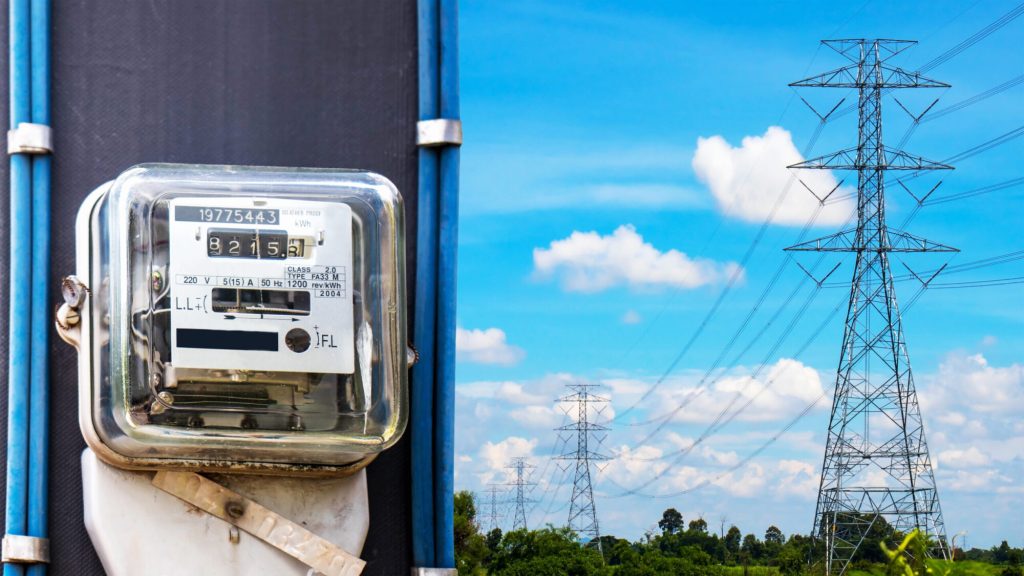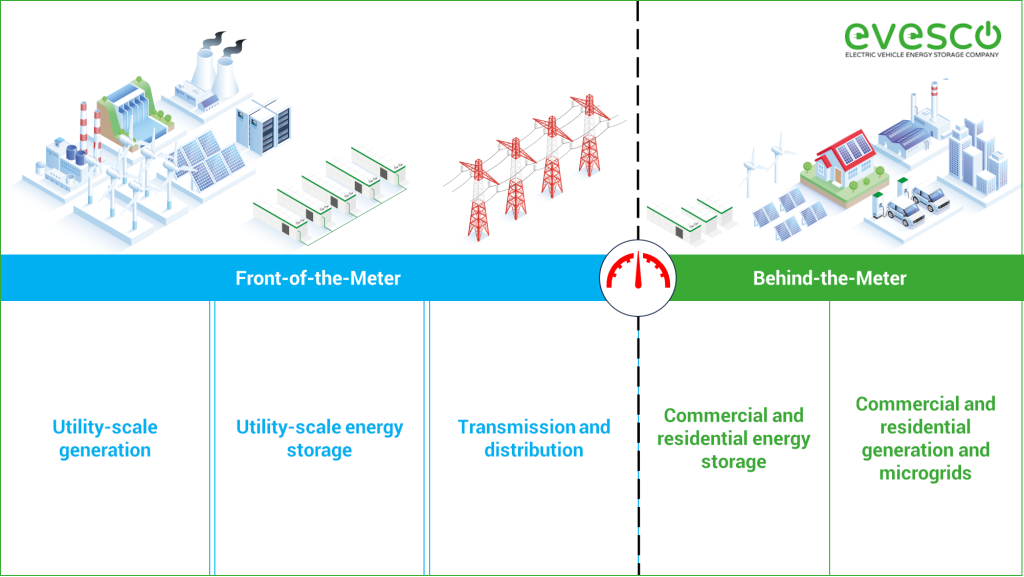Behind the Meter vs. Front of the Meter – What’s the difference?

As energy costs rise and climate concerns grow, companies increasingly adopt Behind-the-Meter (BTM) systems. These customer-side technologies, like solar panels and batteries, let users generate, store, and manage energy.
This article explains BTM, contrasts it with front-of-the-meter systems, explores key technologies, and highlights its benefits.
BEHIND-THE-METER
Behind-the-meter (BTM) refers to the energy systems located on the customer’s side of the utility meter. These systems—solar panels, batteries, or efficient appliances—mainly power the building, reduce grid use, lower bills, and can sell excess energy for income or credits.
FRONT-OF-THE-METER
Front-of-the-Meter (FTM) systems, located on the utility side, include large-scale generation and storage like power plants, wind farms, and solar parks. They supply the grid, balance supply and demand, stabilize energy, and support renewable integration.
BEHIND-THE-METER VS. FRONT-OF-THE-METER
While behind-the-meter and front-of-the-meter systems are integral parts of the energy mix, they serve different roles and impact energy users differently. Behind-the-meter systems allow customers to take control of their energy generation and use, offering potential cost savings and increased resilience. Front-of-the-meter systems are essential for energy supply and grid stability, especially during the shift to renewable energy sources.

EXAMPLES OF BEHIND-THE-METER-SYSTEMS
- Solar PV Systems: Convert sunlight to electricity, reducing grid reliance and bills. Scalable for homes or commercial sites.
- Battery Energy Storage Systems (BESS): Store excess energy for later use, especially paired with solar, to improve self-sufficiency and cut peak-time costs.
- Wind Turbines: Generate renewable electricity, ideal with storage in remote areas with strong winds.
- Combined Heat and Power (CHP): Produces electricity and usable heat from a single source, improving energy efficiency for commercial/industrial use.
- EV Charging Stations: When paired with renewables and storage, they reduce grid demand and optimize energy use.
- Energy Management Systems (EMS): Monitor, control, and optimize energy use, often using AI for demand forecasting.
- Fuel Cells: Generate electricity via chemical reactions (often hydrogen), offering efficient, low-emission power.
- Microgrids: Localized grids combining multiple generation sources with storage, providing resilience and independence.
- Geothermal Systems: Use underground heat for heating, cooling, and sometimes electricity, offering long-term savings and environmental benefits.
- Demand Response Systems: Adjust consumption in response to utility signals to reduce costs and support grid stability.
- Smart Appliances: Optimize energy use based on availability and cost, especially when combined with energy storage.
These examples highlight behind-the-meter solutions, chosen based on energy needs, resources, location, and budget. All aim to optimize energy use, cut costs, support the grid, and promote a sustainable, resilient energy future.
EXAMPLES OF FRONT-OF-THE-METER SYSTEMS
- Utility-Scale Solar Farms: These large-scale installations of solar panels generate considerable amounts of electricity that feed directly into the grid. They’re typically located in areas with high levels of solar and contribute to a clean, renewable energy supply.
- Wind Farms: Wind farms consist of multiple wind turbines that convert wind energy into electricity on a large scale. The electricity generated is fed into the grid, supplying power to homes, businesses, and industries. Wind farms are a crucial part of many countries renewable energy infrastructure.
- Hydropower Plants: Hydropower plants harness the energy created from falling or flowing water to generate electricity. They are often located at dams or rivers and can supply large amounts of renewable energy to the grid.
- Natural Gas Power Plants: Generate electricity with lower carbon emissions than coal or oil, offering flexible, reliable bridge power for renewable transition.
- Large-Scale Energy Storage: Store excess energy and release it during high demand, supporting grid stability and renewable integration; must meet quality standards like UL-9540.
- Nuclear Power Plants: Provide base-load power with minimal greenhouse emissions, though controversial due to waste and safety concerns.
- Grid Management Systems: Use data and AI to balance supply and demand, integrate renewables, manage outages, and maintain grid stability.
These front-of-the-meter examples collectively ensure a consistent and reliable supply of electricity. Each one plays its unique role, whether generating renewable energy, providing energy storage, or ensuring the smooth operation of the entire grid. As the global energy systems evolve, these front-of-the-meter solutions and the various behind-the-meter solutions will facilitate a future sustainable, resilient, and low-carbon energy mix.
THE BENEIFTS OF BEHIND-THE-METER-SYSTEMS
Commercial and industrial energy users often operate on a large scale, with sizable energy requirements. As a result, they stand to gain a lot from installing behind-the-meter systems. Here’s why these entities might go for behind-the-meter solutions and the benefits they could reap:
- Cost Savings: Generate your own electricity and store excess energy to avoid peak pricing and reduce grid dependence.
- Energy Independence & Security: Maintain operations during outages with on-site generation and storage.
- Sustainability Goals: Use renewables to lower carbon footprints and meet corporate sustainability targets.
- Regulatory Compliance: Meet local regulations and qualify for incentives like tax credits or rebates.
- Improved Power Quality: Reduce voltage dips, swells, and interruptions for sensitive equipment.
- Load Management: Optimize energy use, shift loads off-peak, and participate in demand response programs.
Choosing the right system depends on a company’s needs—solar PV for sustainability, battery storage for high-demand or resilience, or a combination—enabling cost reduction, energy independence, and sustainability.
BEHIND-THE-METER-PROJECTS
Several well-known companies have successfully implemented behind-the-meter systems and are reaping substantial benefits. Here are a few compelling examples:
- Apple: Apple’s headquarters in California, known as Apple Park, features one of the world’s largest on-site solar energy installations. It includes 17 megawatts of rooftop solar and 4 megawatts of biogas fuel cells. Apple has also installed on-site battery energy storage to store excess power. The company states that globally they are powered entirely by renewable energy.
- Walmart: Uses solar panels and wind turbines to support its goal of 100% renewable energy by 2035, reduce costs, and participate in demand response programs for grid stability and incentives.
- IKEA: Installs solar panels and wind turbines worldwide, achieving 76% renewable electricity in 2022 and aiming to be climate positive by 2030.
- Mars Inc.: Powers many global sites with solar and wind, with U.S. operations fully renewable, including energy from the Mesquite Creek wind farm.
These companies cut energy costs, advance sustainability goals, boost energy independence, and lead in the transition to renewable energy.



